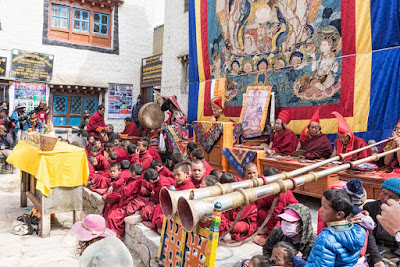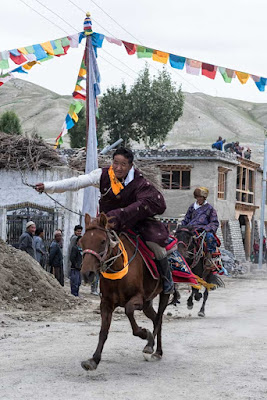In 2019, I went on three major journeys to photograph "ordinary people doing extraordinary things".
The first journey was at the end of May. I returned to Upper Mustang, "The Former Kingdom of Lo", for the third time in three years ostensibly to witness and document a major festival, Tiji Festival" held in Lo Manthang.
The Tiji Festival is one of the two major festivals held in Lo Manthang each year. It is held typically at the end of May and early June, prior to the start of the rainy season. The other major festival, which I attended the previous year, is "Yartung Festival, which is held at the end of the rainy season in August.
In the 17th century the King of Mustang invited the Sakya Trizin (Holder of the Sakya Throne) in Samye Monastery in Tibet, the home of Vajrakila sacred dance, to reside at the Chode Monastery in Lo Manthang. The Tibetan culture and tradition is very strong in Mustang. Today it is said that Upper Mustang is more like Tibet than the post WWII Chinese dominated Tibet of today.
While at the Chode Monastery, the Sakya Trizin performed a special Vajrakila ritual for the well being of all conscious as well as mindful beings such as divinities, humans, animals, tormented spirits, and denizens of hell. He started a Cham, sacred Vajakila dances, associated with meditation.
Since that time in the 17th century, the Monks of Chode Monastery have been performing the dance and rituals. Just as the Chams of Bhutan, every intricate movement, gesture, and expression of the dancer is prescribed and holds significant meaning. In performing the Cham the Monk dancer has meditated to become the deity that he portrays.
The Tiji Festival, "Prayer for world peace", is a very religious Vajrayana Buddhist purification ceremony and ritual that commemorates the legend of a son who defeated his father in order to save the Kingdom of Lo. The son, a deity named Dorji Jono, fought his demon father who had brought drought which caused famine in the land.
The Tiji Festival, which is held at the end of the dry season and the start of the wet growing season, commerates the victory of good over evil.
The Tiji Festival is a three day event. In 2019 the first day of the festival was May 31st. On the morning of the 31st, I attended a puja, a religious ritual, at the Chode Monastery. I did not take any photographs because photography is not allowed UNLESS you had purchased a special permit just for that event. If I remember is was something like $100 for two hours.
 |
| Unfurling the Thankla |
In the afternoon, the ceremony started with a procession of costumed Monks from the monastery to the courtyard south of the Palace Gate and East of the Royal Palace. I had been informed that the festivities would commence at 1:00 PM. I arrived early, around 12:00 PM in order to not miss anything. The area for spectators was already rapidly filling with people - locals as well as tourists. I found a good location and sat on the cobble stone paving to await the start. 1:00 PM came and went. I spoke with some people and they informed me that the ritual would start around 2:00 PM. 2:00 PM came and went. I spoke with a monk that I know in Lo Manthang and he informed me that the start would be at 3:00 PM. 3:00 PM came and went. However, at 3:30 PM the festivities actually started. The wait and confusion is fairly typical for events in Upper Mustang. Waiting is not all that unpleasant when you are surrounded by such beautiful scenery, ancient buildings, interesting local residents, and perhaps just as important - protecting your vantage point from the ever increasing number of spectators.
 |
| A Grandfather Escorts His Grandson |
 |
| Monks Arriving at the Festival Site |
 |
| Monk Performing Cham |
The second afternoon, was highlighted by unfurling the ancient Thangka. The ancient tapestry is said to be 400 years old. It depicts the image of the Padmasambhava also known as Guru Rinpoche. Guru Rinpoche was an 8th century Buddhist master. He constructed the first monastery in Tibet. He he is widely worshiped as the second Buddha by devotees of Tibetan Buddhism, typically found in Tibet, Nepal, Bhutan, and the mountainous areas of India.
Devotees of Tibetan Buddhism believe that viewing the sacred dances and the thangka brings them peace as well as prosperity. The chams performed during the Tiji Festival cleanses Lo Manthang and surrounding area of evil spirits.
 |
| Unfurling the ancient thangka of Guru Rinpoche |
The afternoon of the second day of the Tiji Festival, is filled with sacred dances, Chams. The Chams performed on that day are more energetic and lively than the ones performed the previous afternoon.
 |
| Local women pay their respects to Guru Rinpoche |
 |
| Lamas play cymbals and blow radong (long horn) |
 |
| Monks Performing Durdag Cham - Lord of the Cremation Ground Dance |
 |
| Lord of the Cremation Ground Dance |
 |
| Young Monk Performs Cham |
On the third day of the festival, June 2, involved more sacred cham performances at the festival site. At approximately, 5:00 PM there was a procession lead by the Lamas from the festival site through the streets of Lo Manthang to a field outside of the village.
 |
| Inside of Lo Manthang, Lamas beat drums and chant |
At the edge of town, the man who many people recognize as the King stopped and lit the musket held by his bodyguard. The matchlock musket erupted in a thunderous clap and filled the air with copious clouds of white smoke along with fragments of paper. The firing of the musket is to banish evil from the town.
 |
| The "King's" Bodyguard Holds and Ancient Musket that the "King" Has Just Fired. |
Once the procession had cleared the village of Lo Manthang, the ritual was concluded in an open field with the snow capped Himalaya mountains as a backdrop. Several times, the ancient matchlock muskets were fired to signify the destruction and defeat of Dorjee Jono's evil father for the benefit of Lo Manthang and the Lowa people. Firing of the muskets also banished any current demons from the region.
 |
| Outside of Lo Manthang, a man loads his ancient musket |
 |
| Men Prepare Musket to be fired |
 |
| Ramming the Charge |
I am glad that I attended the Tiji Festival. It was a interesting and unique experience.
Would I return to the Tiji Festival?
Having "been there and done that", I can honestly say that I would not return to the Tiji Festival.
The ritual and ceremony met all my expectations. The photo opportunities met my needs.
The local people were friendly and very photogenic. It was a pleasure to see some friends once again and to make some new friends.
However, I did not completely enjoy my visit like during the previous two journeys to Lo Manthang.
The problem on this visit were the other foreign visitors. There were not necessarily a great number of foreign visitors but I estimate that there were approximately 200 foreigners. For a "town" of 500 residents, the amount of visitors made a big impact.
Two hundred visitors in the confined space of the Royal Palace Courtyard along with the local people attending THEIR festival was difficult.
I can tolerate the number of visitors. I can even live, but grudgingly, with some of them wearing bright yellow or red jackets - who wants photographs of an ethnic festival with brightly dressed foreigners conspicuously in the background? I always attend dressed in tan and black to minimize my visual impact on others.
What I have a low tolerance for and have difficulty in accepting is the poor behavior of some visitors. Granted that most visitors behave properly but there is a certain percentage of people who behave poorly. The greater the number of people in any group, the greater the number of miscreants. I have also found that certain nationalities also tend to be more prevalent to poor public behavior.
Americans used to be considered to be the world's worst tourists. They have been superseded by Chinese, South Korean, Russian, and German tourists. I suspect that Italian tourists could also outrank the Americans now.
The Tiji Festival is highly publicized and touted for tourism to Upper Mustang. Although Upper Mustang receives approximately 3,000 visitors a year, the vast majority of them arrive for the three day Tiji Festival. Most have not done their homework as to what the festival is about, and most of all how sacred and important it is to the local people.
The festival is for the local people. They believe that just by attending and witnessing the ritual, they will receive blessings and merit. The festival is not a commercial event to attract tourists and their money.
Some of the visitors that I observed behaved as if the festival was being conducted for their benefit and entertainment. That did not excuse their boorish behavior. On the right hand side of the courtyard, there were a series of well made long benches with red plush cushions on top of them. HINT. HINT! They were obviously not intended for tourists! Other than the chairs set up on the opposite side of the courtyard with "VIP" signs on them, there were no other seating arrangements at the performance venue.
I realized right off the bat that these benches were for the Monks. Taking advantage of that, I stood right behind them with my knees against the bench - I knew that the young Monks would not be standing and I would have an unobstructed view of the ritual.
Many tourists came and sat on the benches before the start of the ritual. Perhaps they did not know or realize. Some of the tourists sat and refused to move even when they were told that the benches were for the Monks. As the young Monks stood before them, they would not move. Even when they were informed by the local people they refused to allow the Monks to use the benches. Only after an authority figure in a uniform arrived did they reluctantly vacate the benches.
The area of the courtyard where the cham is performed is sacred ground having been purified before the start of the ritual and marked out in two large concentric red lines placed by a Monk pouring the red liquid on the cobble stoned courtyard. This did not stop some tourists from sitting in the space and refusing to move or respect the area when informed ...until an authority figure appeared with a baton to move them.
Some people behaved even more disgracefully. There was one Chinese female tourist who kept violating the sacred space to squat and get "HER" shot. Her presence at times interfered with the movement of the performers. Despite protests from local as well as other tourists she persisted with her obnoxious and inconsiderate behavior. She became well known and despised throughout the festival.
One foreign man would stand in front of the seated local people at the edge of the audience obstructing their view. He was not there for a short period of time to take a photo but to watch the ritual! At other times I saw him placing his hand on local people to move them.
These were all behaviors that I had not observed in Lo Manthang during my other trips. It was not an environment that I enjoy or prefer.
































